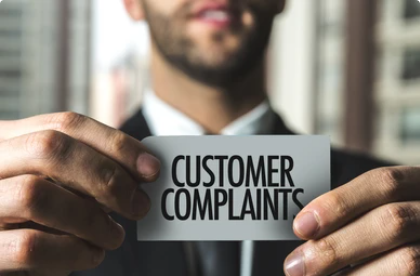Popular Posts
- Order Management
- TikTok Shop
- Temu
- About 4Seller
- Amazon
- Shopify
- Inventory Management
- Amazon MCF&FBA
- Amazon Shipping
- UPS
- FedEx
- DHL Express
- Listing Management
- Creator Bulk Invite
- GLS
- Seller Tips
- eBay
- Shein
- Marketplace News
- Royal Mail
- Amazon MCF
- Walmart
- Multi-channel Store
- Logistics Rule
- Shipping Integration
- Stripe Tracking Sync
- Poste Italiane
- UniUni
- USPS
- PayPal Tracking Sync
- OTTO
- Walmart WFS
- Yodel
- Kaufland
- BRT
- CaiNiao
- Chronopost
- CIRRO
- Correos
- Correos Express
- Deutsche Post
- DHL Parcel
- Etsy
- Evri
- GOFO
- Inventory Sync
- Beginner Tutorial
- DPD
- Shipping Label
- DHL
- FBM
- Platform Integration
- AliExpress
- 3PL
- Cdiscount
- OMS
- WooCommerce
10 Useful Tips for Dealing with Customer Complaints (2024)
 By Karen30 Apr,2024
By Karen30 Apr,2024As an e-commerce seller serving the public, it's difficult to satisfy everyone. Everyone makes mistakes.
However, knowing how to handle customer complaints with competence is vital. This may even result in making the unhappy customer a return customer. It's crucial to have a reliable strategy in place to handle these situations.
The Importance of Handling Customer Complaints Properly
Properly handling customer complaints is crucial for the success and reputation of any business. Here are some reasons why it is important:
- Retention of customers
- Reputation management
- Improved customer service
- Upselling potential

Responding to customer complaints can be difficult, but it's crucial to train your customer service team on how to handle common complaints and resolve issues quickly and effectively.
Follow these steps to handle complaints and ensure that customers are satisfied with the outcome.
- During the process of problem-solving
Acknowledge the customer's complaint and take the time to listen to their concerns and understand the issue they are facing.
Using Socratic questioning can help you to get to the root of the problem. To do this, you can ask customers like:
- What do you mean by…?
- Could you give me more details?
- Could you show me your info like…?

Different types of customers have different attitudes and needs when it comes to complaints. Some are confrontational, some demand premium service, some contact frequently, and some may never complain at all. It's important to respond appropriately to each customer to resolve their complaints and retain their business.
3. Have empathy & Apologize
Apologize for any inconvenience caused to the customer and acknowledge their frustration or disappointment.
4. Be calm, polite and professional
Remain polite, respectful, and professional throughout the conversation. Remember that the customer's experience with your business may influence their decision to purchase from you again.

Offer a solution to the problem, in a timely and professional manner. It could be a refund, replacement, or other compensation that would provide some resolution to the issue.
6. Set up a chatbot
Having a chatbot in your business is common now and is a smarter choice for improving customer service with faster response times.
It is also easier to obtain and maintain compared to a Virtual Assistant. However, Virtual Assistants are necessary for handling more complex customer issues that cannot be handled by automated responses.
- After presenting the solution
Finding a solution that satisfies the customer is crucial after gathering all the necessary information. The faster the problem is resolved, the happier the customer will be.
However, it's also essential to be flexible and go beyond company protocols to offer a solution that can be fulfilled. This can include issuing a gift card or replacing the item, among other options. Giving employees the autonomy to make judgment calls can help avoid exacerbating the situation by passing it up the chain of command.
8. Follow-up
After providing a solution, follow up with the customer to confirm that the issue is resolved and they are satisfied with the outcome.
9. Record and collect the issues
Keep a record of your interactions with customers from the time a complaint is submitted until it is resolved. This will help improve products, services, and customer experience. It will also provide context for future complaints from that customer.

Use the feedback from customer complaints to identify areas where your business may need improvements. This could be in your product or your customer service process.
Conclusion
According to a study conducted by American Express, 78% of consumers have backed out of a purchase due to poor customer service.

By following the above 10 useful tips, you'll be able to handle customer complaints effectively, maintain a positive relationship with your customers and enhance the reputation of your business.
Topics
All Topics
- Order Management
- TikTok Shop
- Temu
- About 4Seller
- Amazon
- Shopify
- Inventory Management
- Amazon MCF&FBA
- Amazon Shipping
- UPS
- FedEx
- DHL Express
- Listing Management
- Creator Bulk Invite
- GLS
- Seller Tips
- eBay
- Shein
- Marketplace News
- Royal Mail
- Amazon MCF
- Walmart
- Multi-channel Store
- Logistics Rule
- Shipping Integration
- Stripe Tracking Sync
- Poste Italiane
- UniUni
- USPS
- PayPal Tracking Sync
- OTTO
- Walmart WFS
- Yodel
- Kaufland
- BRT
- CaiNiao
- Chronopost
- CIRRO
- Correos
- Correos Express
- Deutsche Post
- DHL Parcel
- Etsy
- Evri
- GOFO
- Inventory Sync
- Beginner Tutorial
- DPD
- Shipping Label
- DHL
- FBM
- Platform Integration
- AliExpress
- 3PL
- Cdiscount
- OMS
- WooCommerce
Popular Posts
- 17 Dec,2024
Popular Posts
- 17 Dec,2024
Back to top




